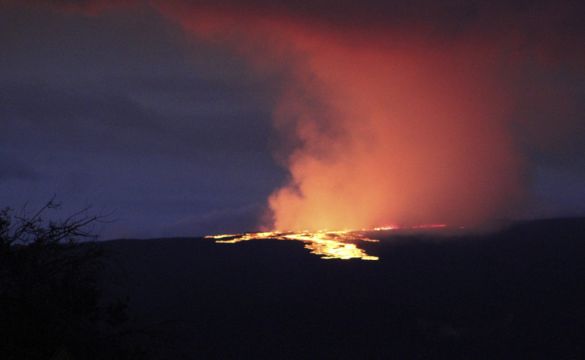The world’s largest active volcano has begun to erupt, and while it was not immediately threatening communities on Hawaii’s Big Island, officials warned residents to be ready for worse.
Many current residents were not living there when Mauna Loa last erupted 38 years ago. The US Geological Survey warned the roughly 200,000 people on the Big Island that an eruption “can be very dynamic, and the location and advance of lava flows can change rapidly”.
The eruption began late on Sunday night following a series of fairly large earthquakes, said Ken Hon, the scientist-in-charge at the Hawaiian Volcano Observatory.

There has been a surge of development on the Big Island in recent decades — its population has more than doubled, from 92,000 in 1980.
Most of the people on the island live in the city of Kailua-Kona to the west of the volcano, which has about 23,000 people, and Hilo to the east, with about 45,000.
Officials were most worried about several subdivisions about 30 miles to the south of the volcano, which are home to about 5,000 people.
A time-lapse video of the eruption from overnight showed lava lighting up one area, moving across it like waves on the ocean.
The US Geological Survey said that the eruption had migrated to a rift zone — a place where the mountain rock is cracked and relatively weak — making it easier for magma to emerge.
An eruption from the zone could send lava toward the county seat of Hilo or other towns in East Hawaii but it could take the lava weeks or months to reach populated areas.
Be sure to follow @USGSVolcanoes for updates on the #MaunaLoa eruption. https://t.co/RNsL4VUBzM
— USGS (@USGS) November 28, 2022
Advertisement
“We don’t want to try and second-guess the volcano,” Mr Hon said. “We have to let it actually show us what it’s going to do and then we inform people of what is happening ASAP.”
Hawaii County Civil Defence announced that it had opened shelters because it had reports of people evacuating from along the coast on their own initiative.
The average Mauna Loa eruption is not typically prolonged, lasting a couple of weeks, Mr Hon said.
“Typically, Mauna Loa eruptions start off with the heaviest volume first,” Mr Hon said. “After a few days, it starts to calm down a little bit.”
The USGS warned residents at risk from Mauna Loa lava flows to review their eruption preparations. Scientists had been on alert because of a recent spike in earthquakes at the summit of the volcano, which last erupted in 1984.
Portions of the Big Island were under an ashfall advisory issued by the National Weather Service in Honolulu, which said up to a quarter of an inch of ash could accumulate in some areas.
Mauna Loa is one of five volcanoes that together make up the Big Island of Hawaii, which is the southernmost island in the Hawaiian archipelago.
Mauna Loa, rising 13,679 feet above sea level, is the much larger neighbour of Kilauea, which erupted in a residential neighbourhood and destroyed 700 homes in 2018.
Some of its slopes are much steeper than Kilauea’s, so lava can flow much faster when it erupts.
During a 1950 eruption, the mountain’s lava travelled 15 miles to the ocean in less than three hours.







